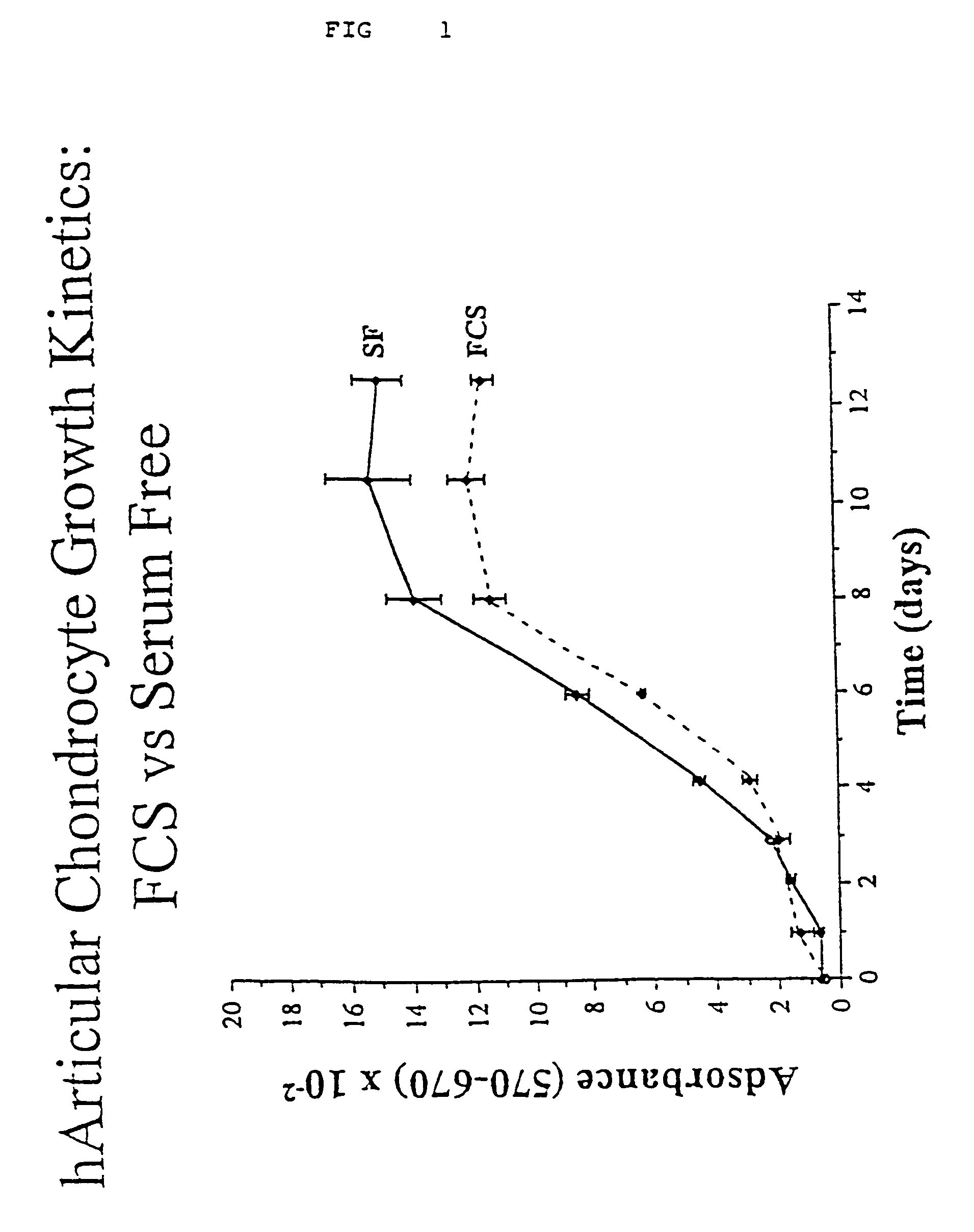Serum-free medium for mesenchymal stem cells
a mesenchymal stem cell and serum-free technology, applied in the field of serum-free medium for mesenchymal stem cells, can solve the problems of high variability between animal serum batches, time-consuming and labor-intensive preparation of autologous serum from patients, and certain disadvantages and limitations
- Summary
- Abstract
- Description
- Claims
- Application Information
AI Technical Summary
Benefits of technology
Problems solved by technology
Method used
Image
Examples
example 1
[0028]Articular cartilage was harvested from the knee joint of young adult human donors. The samples were first cleaned of any adherent muscular, connective or subchondral bone tissues, minced into 1–3 mm fragments and rinsed in PBS. Single chondrocytes were then released by repeated enzymatic digestions at 37° C. with 0.25% trypsin, 400 U / ml collagenase I, 1000 U / ml collagenase II and I mg / ml hyaluronidase. Trypsin was then blocked and removed by rapid and extensive washes in PBS containing soybean trypsin inhibitor. Cells were plated in anchorage-dependent conditions in Coon's modified Ham's F-12 medium supplemented either with 10% fetal calf serum (FCS, control culture) or the following defined components: EGF, PDGFbb and FGF-2, ascorbic acid, linoleic acid, human serum albumin (HSA), β-mercaptoethanol, dexamethasone, insulin, human holo- and apo-transferrin. Table 1 below shows the preferred amounts of each component. To favor adhesion of the cells in serum free conditions, the ...
example 2
[0031]Bone marrow sample harvested from the iliac crest of the patient was washed twice with PBS. The nucleated cells were counted using methyl violet and plated at 5×106 cells as unfractionated marrow per 10 cm tissue culture dish. For selection and expansion, the cells were maintained in Coon's modified Ham's F12 (F12) supplemented either with 10% FCS and 1 ng / ml FGF-2 (control culture) or the following defined components: EGF, PDGFbb, FGF-2, LIF, SCF, IGF-I, ascorbic acid, cholesterol, HSA, β-mercaptoethanol, dexamethasone, human holo- and apo-transferrin, selenium, biotin and sodium pantotenate. Table 2 below shows the preferred amounts of each component. To favor adhesion of the MSCs, the cells were first plated for 48 hours in F12 medium supplemented with 10% human serum and 1 ng / ml FGF-2. Thereafter, the medium was removed and the cells were extensively washed with PBS, and left for an additional 24–48 hours in F12 medium without any supplement. The defined mixture of factors...
example 3
[0035]Growth Kinetics of Chondrocytes
[0036]At day 0, 5×103 first passage cells were plated in each well of a 24-well plate in the presence of FCS. Upon adhesion, the FCS was removed, and the cells were extensively washed with PBS and left for 2–3 days in F12 without supplement to exhaust residual traces of serum. Proliferation was then reinduced by adding either 10% FCS or the mixture of defined components established for chondrocytes. Cell number was evaluated at different days via Thiazolyl blue (MTT) staining. Briefly, culture medium was removed and replaced with 0.5 ml of medium without supplement; then 25 μl MTT (Sigma, St. Louis, Mo.) stock solution (5 mg / ml) was added to each culture being assayed. After a 3 hour incubation the medium was removed and the converted dye solubilized with absolute ethanol. Absorbance of converted dye was measured at a wavelength of 570 nm with background subtraction at 670 nm.
[0037]The data obtained (see FIG. 1) clearly show that the defined medi...
PUM
| Property | Measurement | Unit |
|---|---|---|
| concentrations | aaaaa | aaaaa |
| concentration | aaaaa | aaaaa |
| concentrations | aaaaa | aaaaa |
Abstract
Description
Claims
Application Information
 Login to View More
Login to View More - R&D
- Intellectual Property
- Life Sciences
- Materials
- Tech Scout
- Unparalleled Data Quality
- Higher Quality Content
- 60% Fewer Hallucinations
Browse by: Latest US Patents, China's latest patents, Technical Efficacy Thesaurus, Application Domain, Technology Topic, Popular Technical Reports.
© 2025 PatSnap. All rights reserved.Legal|Privacy policy|Modern Slavery Act Transparency Statement|Sitemap|About US| Contact US: help@patsnap.com

